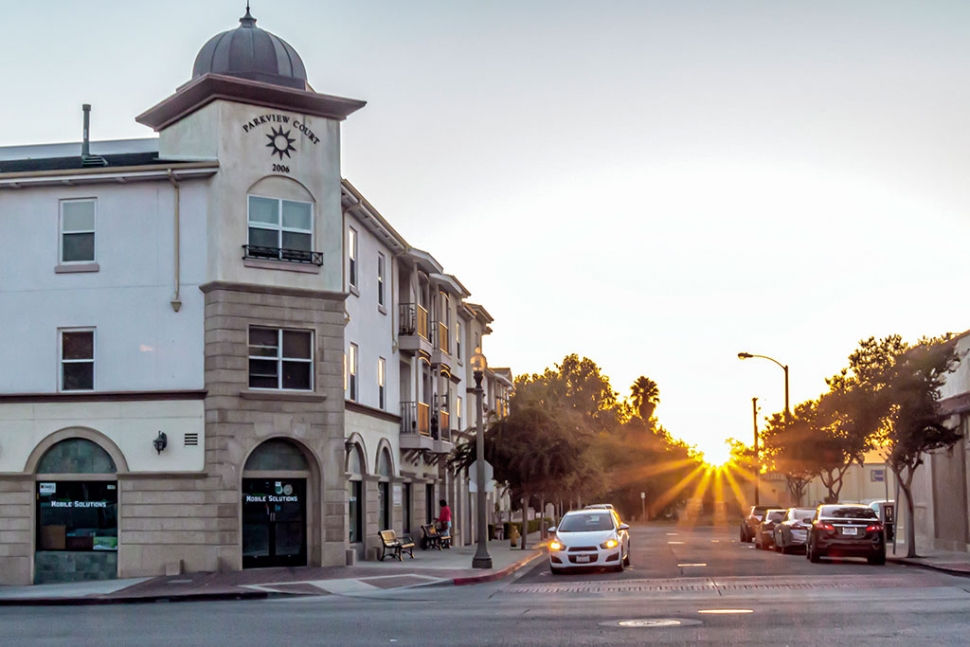|
Focus on Photography
 Photo of the Week: "Sunset on West Main Street by Bob Crum. Photo data: Canon 7DMKII camera, Tamron 16-300mm lens @24mm. Exposure; ISO 2000, aperture f/22, shutter speed 1/60 of a second. By Bob Crum — Wednesday, October 23rd, 2019
In spite of rumors!
 Bob Crum Film-specifically 35mm-was as comfortable as a fleece throw. All I had to do was shoot and hand over the exposed film to a processor. Remember 1-Hour photos? Once made, the prints laid quietly in a dark, sealed envelope. Grasping the envelope, my shaky hands anxiously opened the package. Alas, with prints in hand... some oohs and ahs but oh my, also lots of over-or-under-exposed failures, a.k.a, crap! C'est la vie! As I pursued film photography with a vengeance, digital photography was well entrenched with gear improving by the month. Mattered little! I would rather wrestle a beluga whale than convert to digital. One year at the Ventura County Fair, I shot eight rolls of 36-exposure film. Yes, eight rolls! It was necessary because focus and exposure were of the utmost importance, and it's not possible to 'chimp' film. (chimping is checking the photo just made on the digital camera's LCD screen). For publication, focus and exposure were of the utmost importance. But think about this: 36 x 8 = 288 frames of film. While eight rolls of film may seem like a lot for one day of shooting, it was one-third of a typical day of shooting digital. The significant difference is bad film photos were costly. Ma'am, there are 17 lousy photos in this pack, so I deserve a processing refund. But sir, we didn't screw up, you did. These days, bad digital photos (yes, I occasionally pressed the shutter button too soon or too late) are deleted and marched to the pixel graveyard. Why did I resist converting to digital? Because I'm not any different than most. We often resist learning curves when they are inconvenient, don't we? Learning how to operate a new camera is a daunting task. So many dials. So many options. The menu as pickled as a jar of pigs' feet. And, if RAW photos (equivalent to film) are made, it's also essential to learn photo editing programs on a computer — more anguish. I didn't want any part of any of that. NONE! NADA! My Canon A-1 was working just fine. And I knew it forward and backward. Compose in the viewfinder, adjust exposure, focus and press the shutter button — no reason in the world to change cameras. Then one day, I needed to go to Home Depot in Oxnard. In the same shopping center, I visited a Circuit City store as the company was going out of business. One digital camera remained in the glass enclosure: A Canon Xsi and two kit lenses. It screamed: BUY ME! OK... OK! I gingerly, and nervously handed the clerk a credit card. I bought the camera and both lenses. Ready or not, it was D-(Digital) Day. That little Canon camera ignited a new photographic world that, to this day, I enjoy immensely. Fast forward to now. Phonetographers profusely and loudly proclaim that photography with a dSLR camera is dead, so get over it! Get the Apple iPhone 11 pro with the triple-camera system-ultra wide, wide and telephoto lenses they say. Much easier to whip out the cell phone and take the snapshot they insist. Bidda-bing, bidda-boom, the photo goes viral on the Net. Ha! It's just another snapshot on social media that's forgotten about in three minutes or less. In spite of rumors, as long as creativity is a paramount force of photography, cameras rule! Touché phonetographers! Sunset on Main Street is the photo of the week, another in a series of photos made during the recent PhotoWalk. Proof that we have plenty of photo ops right here in town. Grab your camera and shoot! Send comments, suggestions or questions to: focusonphotography@earthlink.net |
